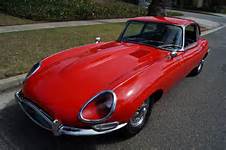Happy Friday to all our readers new and old, hopefully, everyone had a great Easter Sunday as we all did here at Sports Car Services. Today for our weekly “This Week in the Shop” I’d really like to take the time to touch on the Jaguar E-Type and give a brief history of this significant gem.
A couple of weeks ago I briefly touched on this gem and told you that The Jaguar E-Type is an English Sports Car, which was manufactured by Jaguar Cars Ltd between 1961 and 1975. Its combination of beauty, high performance, and competitive pricing established the model as an icon of the motoring world. the E-Type pounced on the scene with a top speed of 150 miles per hour, an acceleration of 0 to 60 mph in 7 seconds, monocoque construction, disc brakes, rack and pinion steering, independent front and rear suspension, and unrivaled looks.
“Monocoque construction”, if you’re like me you probably read that and vaguely had an idea of what it meant and that it had something to do with the outer shell being a supporting member of the vehicle itself. Basically, in all essence, that’s exactly what it means. The E-Type was based on Jaguar’s D-Type racing car, which had won the 24 Hours of Le Mans for three consecutive years (1955–1957), and therefore employed the racing design of a body tub attached to a tubular framework, with the engine bolted directly to the framework.
The Jaguar E-Type was an amazing feat of automobile engineering, on its release in March 1961 Enzo Ferrari called it “the most beautiful car ever made” and he was not exaggerating. The E-Type dominated the foreign car market in its day and quite honestly, in my personal opinion, it still does. There were three different series in the course of its reign from 1961-1975:
The E-Type Series I was produced from 1961- 1968 and featured the triple SU carburetted 3.8-litre six-cylinder engine from the XK150S until 1964 when the 3.8-litre engine was increased to 4.2 litres in October 1964. All E-Types featured independent coil spring rear suspension with torsion bar front ends, and four-wheel disc brakes, in-board at the rear, all were power-assisted. Jaguar was one of the first vehicle manufacturers to equip cars with disc brakes as standard from the XK150 in 1958. The Series 1 (except for late models) can be recognized by glass-covered headlights, small “mouth” opening at the front, signal lights and tail-lights above bumpers and exhaust tips under the number plate in the rear.
suspension with torsion bar front ends, and four-wheel disc brakes, in-board at the rear, all were power-assisted. Jaguar was one of the first vehicle manufacturers to equip cars with disc brakes as standard from the XK150 in 1958. The Series 1 (except for late models) can be recognized by glass-covered headlights, small “mouth” opening at the front, signal lights and tail-lights above bumpers and exhaust tips under the number plate in the rear.
The E-Type Series II was produced from 1968-1971 and introduced a number of design changes, largely due to U.S. design legislation. The most distinctive exterior feature is the absence of the glass headlight covers a wrap-around rear bumper, re-positioned and larger front indicators and tail lights below the bumpers, an enlarged “mouth” which  aided cooling but detracted from the Series I design purity, twin electric fans, plastic rocker switches in place of the Series I toggle switches, and, of course most importantly, a material downgrading in performance resulting from a switch from the three SU carburetors used in Series I models to a mere two “smogged” Stromberg carbs, reducing horsepower from 265 to 246 and reducing torque from 283 to 263.
aided cooling but detracted from the Series I design purity, twin electric fans, plastic rocker switches in place of the Series I toggle switches, and, of course most importantly, a material downgrading in performance resulting from a switch from the three SU carburetors used in Series I models to a mere two “smogged” Stromberg carbs, reducing horsepower from 265 to 246 and reducing torque from 283 to 263.
The E-Type Series III was produced from 1971- 1975 and featured a new 5.3 L twelve cylinder Jaguar V12 engine, uprated brakes and standard power steering. The choice of an automatic transmission, wire wheels and air conditioning were available. The brand  V12 engine was equipped with four Zenith carburetors. The final engine was claimed to produce 272 hp, more torque and a 0-60 mph acceleration of fewer than 7 seconds. The short wheelbase FHC body style was discontinued, with the Series III available only as a convertible and 2+2 coupé. The newly used longer wheelbase now offered significantly more room in all directions. The Series III is easily identified by the large cross-slatted front grille, flared wheel arches, wider tires, four exhaust tips and a badge on the rear that proclaims it to be a V12.
V12 engine was equipped with four Zenith carburetors. The final engine was claimed to produce 272 hp, more torque and a 0-60 mph acceleration of fewer than 7 seconds. The short wheelbase FHC body style was discontinued, with the Series III available only as a convertible and 2+2 coupé. The newly used longer wheelbase now offered significantly more room in all directions. The Series III is easily identified by the large cross-slatted front grille, flared wheel arches, wider tires, four exhaust tips and a badge on the rear that proclaims it to be a V12.

Leave a comment